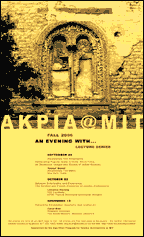Lectures, Conferences & Events» Past Lectures & Events
Carol Bier
Patterning Knowledge: Geometry and Islamic Art
Abstract
Ever since publication of Owen Jones' Grammar of Ornament, geometric pattern in Islamic art has been characterized in the West as decorative and ornamental, and considered non-representational in relation to figural arts. If one delves into the discourse of classical Islamic philosophy and theology, one finds intersections among mathematics, metaphysics, and forms of visual expression. This presentation explores the relationships of number and shape in what we call two-dimensional patterns and three-dimensional space, arguing that geometric forms of expression are culturally significant in Islamic art. This significance, expressed visually in the arts, also likely contributed to the profound impact of Islamic thought on European intellectual development.
Biography
Carol Bier is Research Associate at The Textile Museum in Washington, DC. Her research focuses on pattern, and the meanings of geometry in Islamic art including textiles and Oriental carpets. From 1984 to 2001, she served as curator for Eastern Hemisphere Collections at The Textile Museum, where she organized numerous exhibitions of Islamic textile arts in cultural context. Since 2001 she has served on the Speakers Bureau of the Maryland Humanities Council, offering lectures on "Islam: Religion and Culture," "Plato, Geometry, and Islamic Art," "Islamic Encounters with Other Cultures: An Architectural Journey," and "Looking at Oriental Carpets." She now resides in Berkeley, CA.
For over a decade, Ms Bier taught in the Advanced Academic Programs (Master of Liberal Arts) at Johns Hopkins University, and at the Maryland Institute College of Art. She is author of The Persian Velvets at Rosenborg (Copenhagen, 1995), editor and contributing author to Woven from the Soul, Spun from the Heart: Textile Arts of Safavid and Qajar Iran (16th-19th Centuries ) (Washington, 1987), and former editor of The Textile Museum Journal. She has published articles, book chapters, reviews, and encyclopedia entries in the fields of Near Eastern archaeology, Islamic art, and textile history. Currently, she serves on the Editorial Board of the newly established Journal of Mathematics and the Arts , and is incoming President of The Textile Society of America.
Her award-winning on-line exhibition, "Symmetry & Pattern: The Art of Oriental Carpets" is hosted by The Math Forum@Drexel, a collaborative project of The Math Forum and The Textile Museum http://mathforum.org/geometry/rugs/. The Math Forum has also posted her students' work at the Maryland Institute College of Art http://mathforum.org/geometry/rugs/resources/practicums/.
Lorraine Declety
Between Scholarship and Experience: The German and French Discourse on Islamic Architecture
Abstract
This presentation will focus on the making of Islamic architectural history in Germany and France in the 19th century. It will concentrate on accounts and their authors, the paradigms they used as well as their illustrations. The comparison will allow me to show how, despite important methodological and theoretical differences, those accounts contributed to create a dominant discourse on Islamic architecture and to organize aa strict hierarchy. It will also lead us to question the validity of the link between knowledge and power.
Biography
Lorraine Declety studied history at the École nationale des Chartes and Islamic art at the École du Louvre, Paris. After her DEA on the subject of orientalist architecture in 19th century Paris at the École pratique des hautes écoles in Paris, she is pursuing her PhD on orientalist architecture in 19th century France and Germany at the European Graduate College, Dresden-Paris.
